| |
Mark Twain is mythically credited with the saying, regarding California, “Whisky’s for drinkin’ and water’s for fightin.” We don’t have a lot of either in Richmond right now, but we do have $35 million or scholarships, and the fighting has begun.
The Richmond Promise Program is a $35 million scholarship initiative funded form the $90 million Chevron Environmental and Community Investment Agreement (ECIA) that accompanied Richmond’s approval of the $1 billion Chevron Refinery Modernization Program. $35 million is a lot of money, but it’s not enough for everyone. Other Promise Programs have a lot more. For example, El Dorado, AR was given $50 million by Murphy Oil Corporation. Kalamazoo, MI has unlimited funding from an anonymous donor.
In Richmond, we have to figure out how to spend the limited funds we have, and the fighting has begun over two final but critical policy issues:
- Who is eligible, and
- How will the money be allocated
There are three options for eligibility, all of which are limited to Richmond and North Richmond students:
- Traditional public school graduates only
- Traditional public school and charter school graduates
- Traditional public school, charter school and private school graduates
On Tuesday night, the Richmond City Council split 3-3 on options 2 and 3, so no decision was made. I voted for option 3. For a lot of reasons, I would have preferred limiting the program to traditional public school, because I think they and their students have the greatest need. However, the Richmond Promise is for Richmond, and I felt it was appropriate to allow all Richmond residents to participate. This will about double the number of eligible students and make the second policy decision much more difficult.
The allocation policy question never made it to a vote. Councilmembers wanted more information. Items of contention include whether community college attendees should get more money than is needed for basic tuition and fees and how much the maximum grant to 4-year college attendees should be.
- The staff recommendation was to provide $2,500 per year for four-year college students and $500 to community college students.
- The Ad Hoc Committee recommendation was to provide $4,000 per year to four-year college students and $4,000 to community college students.
- There was a compromise plan for $4,000 per year for four-year college students and $1,000 to community college students.
Some City Council members want to provide community college students the same amount of money as those who have been accepted to and plan to attend four-year colleges. The problem is that at the rate of $4,000 per year, the available funding would be used up in about four years.
Community college fees are about $1,300 a year while CSU fees are about $7,000 a year and UC fees are about $13,000 a year. Every dollar diverted to a community college student is a dollar taken away from a four-year college student who has worked hard throughout high school to become college ready and college qualified. Anyone can attend community college; there are no prerequisites. Many community college students live at home and do not typically have the same expenses as those attending four-year institutions.
Community colleges are great institutions, and they provide an invaluable service, but there is a reason they are called “community colleges.” They are relatively inexpensive and are in our community, and that is to make access convenient and inexpensive. But we want the Richmond Promise program to provide maximum motivation for students to attend 4-year colleges; they statistically have a better completion rate and the financial rewards are much better.
The $4,000 figure is an estimate of what the typical 4-year student would need annually to supplement other grants without having to take out loans. See the charts below that explain how this works. Ideally, we would stick with the $4,000 figure, but the funds would run out of money in about four years. By reducing the amount to $2,000 to $2,500, we might be able to extend the program to as much as ten years, if we can invest on the front end to increase the total.
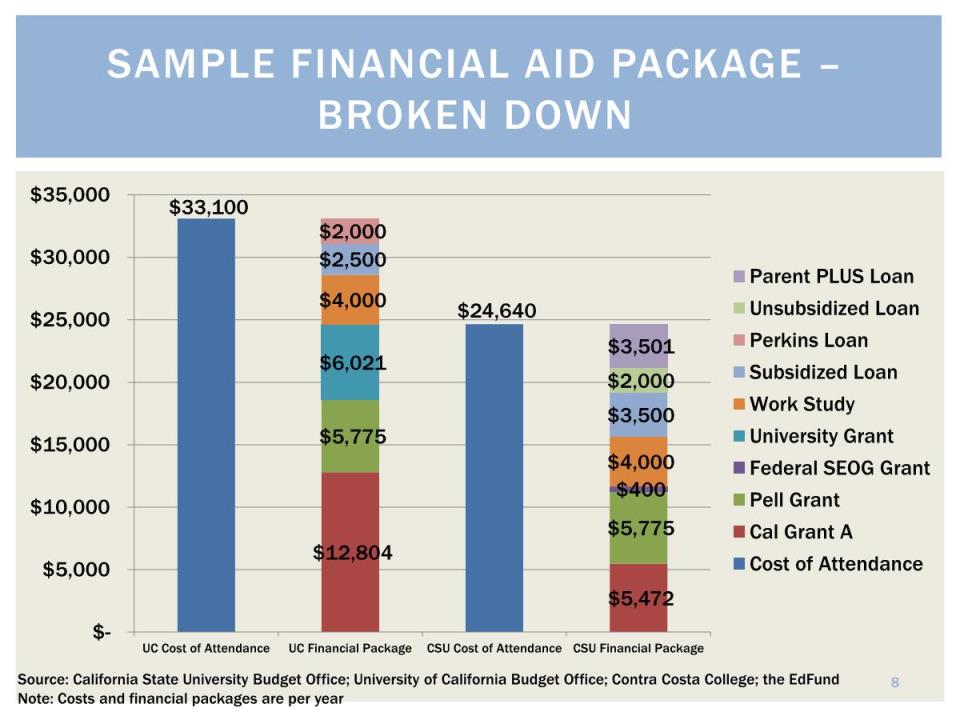
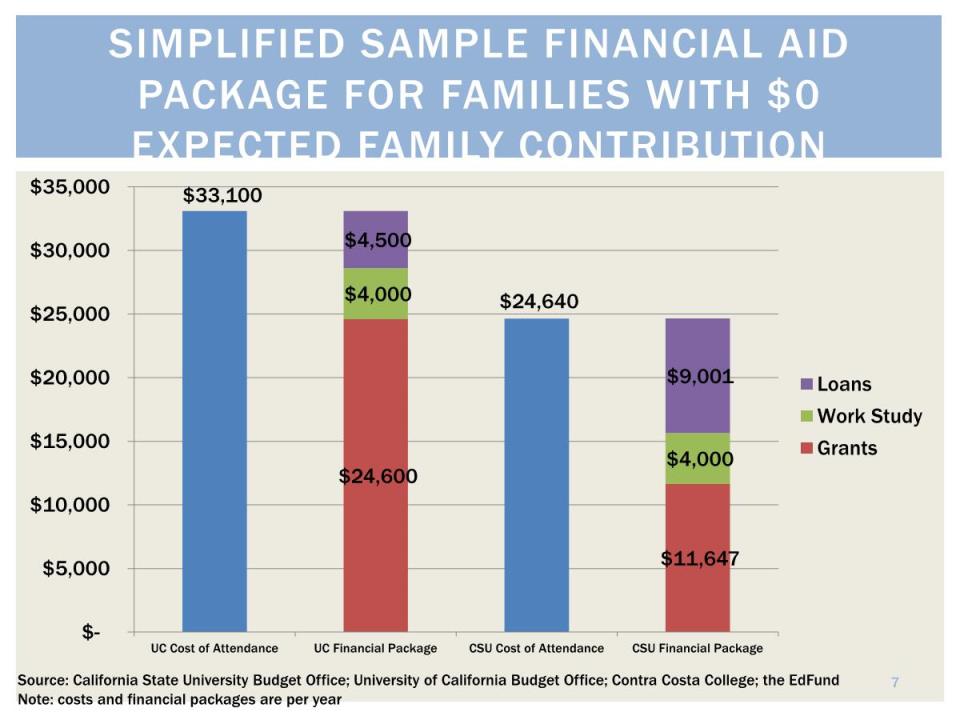
The City Council will take up the Richmond Promise again on November 24.
Tom Butt
Debate on Richmond Promise Stalls Progress
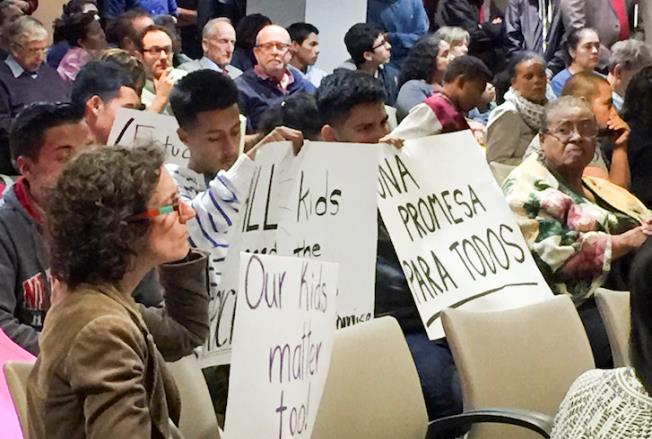
Richmond City Council failed to come to an agreement on key aspects of the $35 million Richmond Promise scholarship program on Tuesday in a lengthy meeting that swung from hectic to tedious.
Council was slated to provide direction to city staff on two key elements of the promise. The issue of eligibility — which students from Richmond West Contra Costa Unified School District (WCCUSD) traditional public schools, the public charter schools, and private schools will be able to receive scholarship funds — was considered in tandem with how much each student would receive, depending on attendance at a community college or four-year institution.
These two decisions have lasting implications on the long-term sustainability and accessibility of the promise program. Before a room packed with charter and private school supporters waving signs, jeering, and applauding throughout the meeting, the divide between the desire to be as inclusive as possible yet ensure that the Richmond Promise program doesn’t immediately burn through the entirety of its $35 million proved difficult to bridge for councilmembers.
“Despite the tension and political interest in the room, this is a really exciting moment,” said Vice Mayor Jael Myrick. “If we do this right it can last…into perpetuity. That’s my number one goal here. How do we do this right so it lasts for generations to come? On the flip side, if we just do what’s convenient now or looks good now, those kids in third grade now won’t be able to benefit from this.”
The general consensus among councilmembers and the vocal public present was to push for inclusion of both WCCUSD traditional public schools and public charter schools. Inclusion of students attending private schools was a much more contentious subject, though, with several members of the Council voicing their opinion that if parents can afford to send their children to a private school, then they can also afford to pay to send their children to college.
“This program was never, ever promised as a program that would include private schools,” said Vice Mayor Myrick. “This is a public agency, this is a public resource, they are for public schools. We need to make sure this money lasts and that the kids who need this money the most are able to benefit from it.”
The debate then branched out into the issue of how much students should receive based on their attendance at a four-year institution or a community college.
“I think we need to move forward with parity for community college,” said Councilmember Gayle McLaughlin. “Staff is recommending $2,250 for community college students and I think we should go forward with that for everyone.”
Some councilmembers and members of the public echoed Councilmember McLaughlin’s push for equal distribution of funds for each group of students, but city staff did not have current information for how long the money would last if it was distributed in this way.
The distribution model presented by city staff on Tuesday that gave equal funds to students at community colleges and four-year institution would provide students $4,000 per year but bankrupt the Promise program within two years. After ten years, such a plan would put the Promise program over $90,000 in debt.
“There is a desire to do things, but the numbers don’t match…We’re saying we have four plus four and want it to equal 68,” said Councilmember Vinay Pimplé. “I am concerned that we are going to vote on something that is completely inconsistent with what we want.”
Mayor Tom Butt also grappled with this issue. “I’m not sure where to go from here, but I’m inclined to make it go as far as it can go while we look for other money rather than burning it up right away,” Butt said.
To resolve this conflict Council directed city staff to crunch the numbers on what it would take to provide greater parity between students at four-year institutions and community colleges and come back later in the evening with an updated report.
The clock was minutes from 11:30 pm — the time limit for meetings — when Council decided to interrupt an item already mid-presentation and call for a vote to extend the meeting to handle the Promise issue. After a quick flurry of motions and substitute motions, Council failed to come to an agreement about extending the meeting, and the meeting was promptly adjourned at 11:30 pm.
Council will take up the issue of the Richmond Promise at the meeting after next, at which time city staff will present updated numbers about equal fund distribution between students at community colleges and four-year institutions.
The $35 million for the Richmond Promise program comes from the Community Benefits Agreement between Richmond and the city’s Chevron refinery as part of their modernization efforts. The goal of the program is to make college accessible to all Richmond students.
If the details of the Promise can be hammered out, Richmond high school students graduating in the class of 2016 are expected to be the first beneficiaries of the scholarship.
Richmond Promise eligibility still on hold
http://richmondconfidential.org/2015/10/28/richmond-promise-eligibility-still-on-hold/
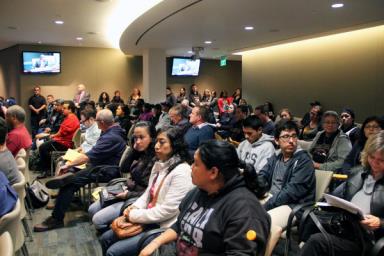
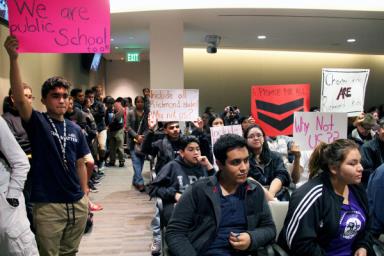
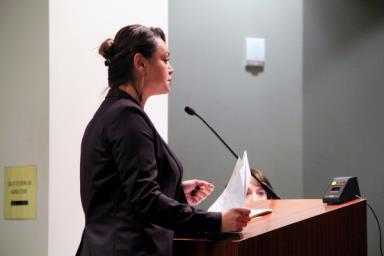
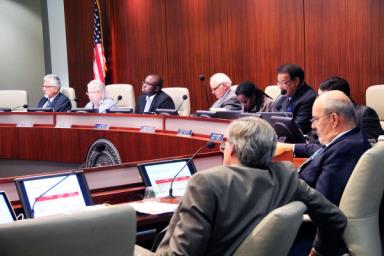
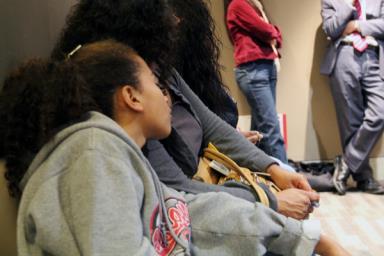
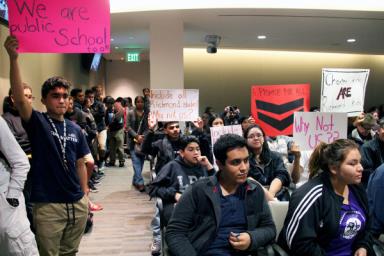
About 100 charter school students, parents, teachers and administrators attended this week's City Council meeting in support of the Richmond Promise being extended to benefit charter school students. A few private school students and parents were also present to advocate for their inclusion in the scholarship program. (Photo by Angelica Casas)
By Paayal Zaveri Posted October 28, 2015 3:04 pm
Following hours of debate and confusion Tuesday night, the Richmond City Council delayed voting on who to make eligible for the “Richmond Promise” scholarship program and how much money students would receive.
Councilmembers had approved an outline for the scholarship program on September 29, but left some key questions open for further discussion, including whether to include charter school students. The $35 million program is backed by a grant from Chevron Corp.
As with previous council meetings involving the Richmond Promise, parents, students and teachers from Richmond-area charter schools packed the room Tuesday night. They expected councilmembers to finally reach a decision about including charter school students.
Councilmembers had trouble reaching consensus on how to expand eligibility and set scholarship levels without causing the program to run out of money too quickly. Some audience members left upset after the council decided to bring up the issue again in a few weeks.
“My students are part of this community, just like everybody else,” said Brian Buttacavoli, a teacher at Making Waves Academy. “They live in our streets, they breathe in that Richmond air from the refinery.”
Earlier Tuesday, the Chamberlin Family Foundation announced that it would add $1 million to the scholarship fund if the council includes charter school students. The foundation funds many of the Richmond-area charter schools.
Several community members were also concerned that community college-bound students will not get the same amount as those going to four-year colleges. One option would award high school graduates going to community college $500 and those enrolling in four-year colleges $2,500.
“I am a community college graduate, and I ask that you follow the committee’s recommendation and not shortchange community college students,” said Mister Phillips, co-chair of an ad-hoc committee that provided policy recommendations for the program.
Supporters say more financial aid will encourage community college students to finish their degrees and transfer to four-year schools to earn their bachelor’s degree.
Many councilmembers agreed, saying that community college also offers valuable opportunities for Richmond students to pursue a college education.
However, Mayor Tom Butt argued that awarding students attending four-year and two-year colleges the same amount doesn’t make sense because the cost is so much higher at four-year schools.
“I don’t understand why its okay to give people a fraction of what just the tuition is at a state college or state university but fully fund the fees at a community college,” Butt said. “That’s more imbalance.”
Several councilmembers said they want to ensure that the scholarship can last for years to come while making sure students get enough money to make college more affordable.
Councilmember Vinay Pimplé said estimates about the program’s financial projections don’t add up.
“I’m a bit concerned about the fact that we are going to vote on something that’s completely inconsistent in terms of what we want in how its going to last,” Pimplé said.
The city estimates around 500 traditional non-charter public school students in Richmond plan on going to college next year, with about 370 at charter schools and 147 at private schools.
Estimates also show that if all three groups are included in the program, the $35 million will run out in about five years. Including just students at non-charter public schools would allow enough funding for about 10 years, according to city evaluations.
Richmond's college-assistance program at impasse
By Karina Ioffee kioffee@bayareanewsgroup.com
Posted: 10/28/2015 08:34:55 AM PDT| Updated: 110 min. ago
RICHMOND -- Priscilla Mariscal is a top-performing high school student, pulling a 4.2 GPA at her charter school.
But as she applies to colleges this fall -- she's eyeing Stanford, UCLA and other top universities -- she has one nagging worry.
Can she afford it?
It would be nice to know that Mariscal can count on a college tuition assistance program being administered by the city of Richmond, with the help of a $35 million payment from Chevron, which operates a refinery in the city.
But despite months of late-night meetings, including a five-hour marathon Tuesday night, ad hoc committees and community workshops, Richmond's leaders have been unable to find consensus on whether students such as Mariscal should be get a share of the pie.
"I think there is a misconception that charter schools have money and that's not true," said Mariscal, 17, who attends Making Waves Academy in Richmond and wants to pursue a medical degree. "We go through the same struggles and we should be allowed the same amount of support as other students."
On Tuesday, charter school students, teachers and parents expected the Richmond City Council to finally reach a decision about whether to include charter school students in the Richmond Promise, the name of the college tuition assistance program.
But after the council failed to narrow down the various policy options and voted to continue discussion of the issue to Nov. 10, those affiliated with charter schools left frustrated and disappointed.
"By only including traditional public schools, we are excluding members of community from an opportunity they need for success to go to college," said Brian Buttacavoli, a teacher at Making Waves Academy. "My students and families shouldn't be punished because they're seeking alternative educational opportunities."
Richmond Promise is modeled on similar programs in Michigan and Arkansas and would pay between $500 to $4,000 a year to every graduating high school senior that enrolls in college, though no amounts have been finalized. It is meant to supplement state and federal financial aid students receive and not replace it, according to city staff.
Although the money may seem insignificant to students in more affluent communities, it's viewed as crucial assistance for many working class students here. The median income for a Richmond family is just $55,000 per year and roughly 75 percent of students qualify for free or reduced lunches, according to the U.S. Census. For Latino families, who make up more than a third of the city, the median income is just $40,000.
The Richmond Promise is being funded through a $90 million community benefits agreement from Chevron, paid out over the next decade. The money is being paid by the oil giant in exchange for the company's upcoming $1 billion modernization project, set to start next year. But the challenge is that the funding is coming to the city in portions, meaning there isn't necessarily enough to invest in an endowment which would extend the life span of the program through dividends.
Although the biggest question for many is whether charter schools will be included, many families are also concerned that students who attend community colleges receive the same amount as those heading off to four-year schools.
"We need parity and what we heard tonight was that the majority of the council supports it," said Michele Jackson, a retired Contra Costa Community College employee. "That's a good sign."
Jackson and other supporters argue that community college students will be less likely to drop out of school if they receive more financial aid. Opponents say on average community college students have a low graduation rates -- just 43 percent -- and that more money should be invested in those heading to four-year schools, where tuition costs are much higher, and who are often higher academic performers.
According to city estimates, about 500 traditional, noncharter public school students who live in Richmond plan on attending college next year, along with 370 students at charters and 147 students at private schools.
If funding is given to all three groups, the $35 million will be gone in just five years. If only noncharter public school students are accepted, there will be enough funding for 10 years, according to city estimates.
Contact Karina Ioffee at 510-262-2726 or kioffee@bayareanewsgroup.com. Follow her at Twitter.com/kioffee |
|

